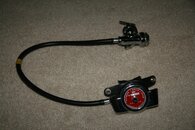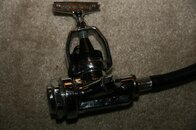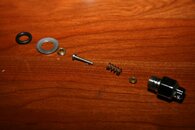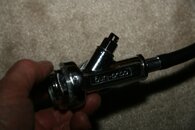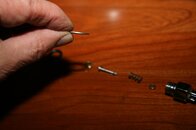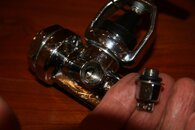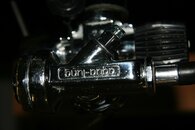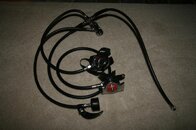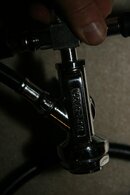You are using an out of date browser. It may not display this or other websites correctly.
You should upgrade or use an alternative browser.
You should upgrade or use an alternative browser.
tapered HP port?
- Thread starter neonistic
- Start date
Please register or login
Welcome to ScubaBoard, the world's largest scuba diving community. Registration is not required to read the forums, but we encourage you to join. Joining has its benefits and enables you to participate in the discussions.
Benefits of registering include
- Ability to post and comment on topics and discussions.
- A Free photo gallery to share your dive photos with the world.
- You can make this box go away
If you get a washer and try it, put it in first without the O-ring, and tighten it down hard. Let the washer bend inwards to make a mating surface with the O-ring on the one side too. This is the way that the originals were designed, and they were a bit concave. It doesn't take much, and you should be able to get a seal. By the way, I looked and I do not have an extra washer or stem gauge.
SeaRat
SeaRat
Last edited:
From nylon or teflon, punch out a 3/8 disc or plug. Drill itsy bitsy hole and drop in port. Tighten down adapter. Add air and water.
That is good advice at 120 PSI; I suggest a little more engineering analysis at 3000 PSI. The good news is a catastrophic failure anywhere in the HP gauge system will probably not kill you since the hole drilled from the port to the supply is pretty tiny — unless there is not enough thread engaged and the fitting becomes a projectile.
If the plastic disc is too thin it can extrude, too thick and not enough engaged threads. There comes a point where $80 for a new fist stage starts to make sense. These are only observations to consider.
Last edited:
I just looked, and both my original Calypso regulators have the washer/O-ring configuration. Both are also in divable condition right now. When I do, I'll share them with you (probably over the weekend). But this works well to make the seal, and my SPG has no problems with thread engagement.
If the washer held at 1500 psig, it should hold at higher pressures. That regulator probably was designed for a 2475 psig tank, and most of these actually could withstand 3000 psig. So you probably don't need to do more about deformation of the washer. My feeling is that USD used a normal washer, and it simply deformed when it was tightened down. The taper is pretty small anyway. As I said above, I will post some photos of the washers that I have here.
SeaRat
If the washer held at 1500 psig, it should hold at higher pressures. That regulator probably was designed for a 2475 psig tank, and most of these actually could withstand 3000 psig. So you probably don't need to do more about deformation of the washer. My feeling is that USD used a normal washer, and it simply deformed when it was tightened down. The taper is pretty small anyway. As I said above, I will post some photos of the washers that I have here.
SeaRat
Last edited:
I don't think you need much in the way of a depression on that washer. If you are getting a seal, that is all that matters.
I've uploaded the photos I took last evening for you to see. This is what the original looked like, along with the stem valve parts. I have photos of the single hose version of the original Calypso regulator, and a second regulator that I have put together with both the original (primary, on the long hose) and the second generation Calypso second stage (as my backup--it breaths well too, but is a wetter breathing regulator). If you'll look at the regulator with four hoses, it has a Sportsways splitter on it, and a very old SPG. This SPG also has the washer on it.
Let's talk about that stem gauge of a moment--it was put on the regulator as a very "quick and dirty" way of seeing whether a tank had air in it. You could roughly tell whether it was full, half full, or a quarter full. My stem gauge is off, and when it is full the stem gauge reads about 3/4 full. Why have one? Well, it allowed a diver to start with a "full" tank, and we were using a J-valve at the time--that was all we needed to dive our rivers and lakes, and the ocean too. I have one closeup photo of the stem gauge with the stem out (on the scuba tank and pressurized). This was before the time when divers were, on a regular basis, cave diving or penetrating wrecks, etc. One part I was unable to show was the O-ring in the top of the stem gauge; I think I saw it, and lubricated it, but was not able to get it out. Since it is sealing, I'm pretty sure it is there right in the top--it looks like one, and acts like one, but I did not pull it out.
Duckbill, I don't think a copper washer would be needed, as he is already getting a seal, and not much of a depression in necessary. Besides, there would then be some corrosion potential simply because of the dissimilar metals.
SeaRat
I've uploaded the photos I took last evening for you to see. This is what the original looked like, along with the stem valve parts. I have photos of the single hose version of the original Calypso regulator, and a second regulator that I have put together with both the original (primary, on the long hose) and the second generation Calypso second stage (as my backup--it breaths well too, but is a wetter breathing regulator). If you'll look at the regulator with four hoses, it has a Sportsways splitter on it, and a very old SPG. This SPG also has the washer on it.
Let's talk about that stem gauge of a moment--it was put on the regulator as a very "quick and dirty" way of seeing whether a tank had air in it. You could roughly tell whether it was full, half full, or a quarter full. My stem gauge is off, and when it is full the stem gauge reads about 3/4 full. Why have one? Well, it allowed a diver to start with a "full" tank, and we were using a J-valve at the time--that was all we needed to dive our rivers and lakes, and the ocean too. I have one closeup photo of the stem gauge with the stem out (on the scuba tank and pressurized). This was before the time when divers were, on a regular basis, cave diving or penetrating wrecks, etc. One part I was unable to show was the O-ring in the top of the stem gauge; I think I saw it, and lubricated it, but was not able to get it out. Since it is sealing, I'm pretty sure it is there right in the top--it looks like one, and acts like one, but I did not pull it out.
Duckbill, I don't think a copper washer would be needed, as he is already getting a seal, and not much of a depression in necessary. Besides, there would then be some corrosion potential simply because of the dissimilar metals.
SeaRat
Attachments
Last edited:
OP
That o-ring looks fatter than the one I used. I also have an o-ring on both sides of the washer. The reg came with a splitter. I am going to keep it for another reg if I need it. Those pics help greatly, thanks!
Similar threads
- Replies
- 32
- Views
- 2,725
- Replies
- 14
- Views
- 861
- Replies
- 2
- Views
- 824




